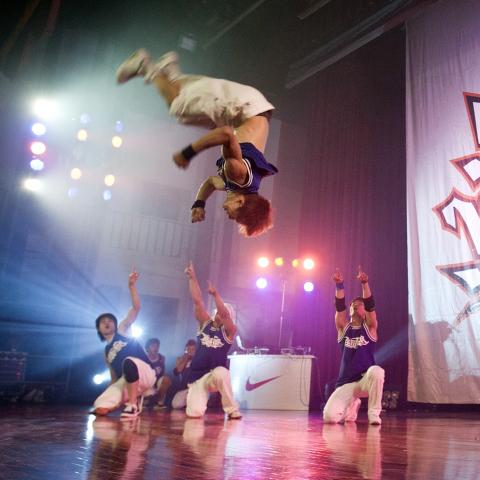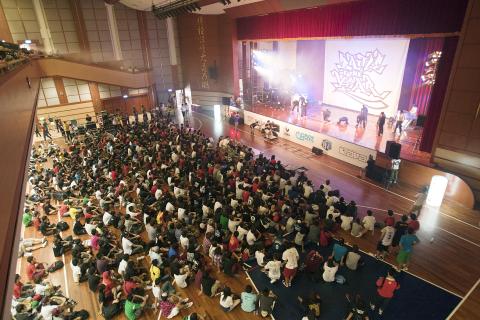Wimbledon’s over and the FIFA qualifiers are slogging along, so why not concentrate on something that really matters? The Taiwan preliminaries for Braun Battle of the Year (BOTY), an annual international competition for break dancing crews, take place in Taipei this weekend.
BOTY was founded in 1990 by Thomas Hergenrother of the Hannover, Germany-based crew Burning Moves. The relatively small contest with around 500 spectators has grown into a widely anticipated event with preliminary competitions worldwide. (The first competition in Taiwan was in 2006.) This year’s BOTY World Final will take place in Montepelier, France, at a venue that seats more than 10,000.
“It’s like the Olympics … The world’s best [break] dancers are gathered together and you see the newest, craziest things,” says Win Chou (周允斌), who manages The Best Crew (TBC) Dance Studio (TBC舞蹈休閒館), the official organizer and host for BOTY Taiwan.

Photo courtesy of BOTY Taiwan
A warm-up match (熱身賽) tomorrow at the new TBC studio in Taipei will feature popping, locking and breaking battles. The BOTY Taiwan main event (主賽事) will be held on Sunday in the Sun Yat-sen Auditorium (逸仙堂) at the Taipei Campus of Ming Chuan University (銘傳大學台北校區). Sunday’s events include a crew “show round,” in which break-dancing groups of at least eight members perform choreographed pieces.
The judges for the main event, American B-boys Ken Swift and Abstrak and Japanese B-boy Katsu, will select four crews for the semifinals. These crews will compete through battles — exchanges of improvised moves — and the winner will represent Taiwan at BOTY Asia against crews from Japan, South Korea, the Philippines, Malaysia and China, among others. The top three crews from BOTY Asia will advance to the BOTY World Final.
Unlike the final, which only has B-boy crew battles, BOTY Taiwan has solo battles for lockers, poppers, and B-boy soloists. The winners in these categories will not go to BOTY Asia, which is a competition for break-dancing crews only.

Photo courtesy of BOTY
“Taiwan’s dancing population is pretty large and it needed a landmark competition, so we included ... a warm-up match with locking, popping and B-boy one-on-one,” Chou says.
Through this additional event, TBC hopes to expose more Taiwanese street dancers to the scale of an international competition.
To simulate the atmosphere of an international competition, TBC is meticulous when it comes to selecting judges. “We choose international judges who are more original, more helpful to Taiwan,” says Chou, who is one of the Taiwanese judges for locking. “If we pick a judge who ... carelessly chooses a winner, when these champions go overseas to Germany or France, they’ll be eliminated immediately.”
Taiwan’s B-boys haven’t been letting their country down. In 2004, before Taiwan had its own preliminary, TBC won the Southeast Asia BOTY regional competition, earning it a ticket to the World Final in Germany. In 2008, Formosa Crew battled its way to the world semifinals and finished with a bronze. “In Asia, the pioneers in street dance culture are Japan and [South] Korea,” says Chou. “They’ve been connected with the European and American dance communities for a long time now. It’s like a miniature United Nations ... Taiwan didn’t become included until around 2004 to 2006, so to these countries we’re pretty new.”
Taiwanese crews are now aiming for second place in BOTY Asia, he says, with presumably Japan or South Korea in first.
The two days of competition in Taipei are open to the public. “We would love to have people who don’t necessarily know dance to come watch,” Chou says. “But it takes a lot of advertising to get the word out there and as of now, we have mostly small sponsors. Also, we’re waiting for the average standard of Taiwanese dancers to get to a certain level to make it even more interesting for viewers.”

Following the shock complete failure of all the recall votes against Chinese Nationalist Party (KMT) lawmakers on July 26, pan-blue supporters and the Chinese Communist Party (CCP) were giddy with victory. A notable exception was KMT Chairman Eric Chu (朱立倫), who knew better. At a press conference on July 29, he bowed deeply in gratitude to the voters and said the recalls were “not about which party won or lost, but were a great victory for the Taiwanese voters.” The entire recall process was a disaster for both the KMT and the Democratic Progressive Party (DPP). The only bright spot for

Water management is one of the most powerful forces shaping modern Taiwan’s landscapes and politics. Many of Taiwan’s township and county boundaries are defined by watersheds. The current course of the mighty Jhuoshuei River (濁水溪) was largely established by Japanese embankment building during the 1918-1923 period. Taoyuan is dotted with ponds constructed by settlers from China during the Qing period. Countless local civic actions have been driven by opposition to water projects. Last week something like 2,600mm of rain fell on southern Taiwan in seven days, peaking at over 2,800mm in Duona (多納) in Kaohsiung’s Maolin District (茂林), according to

Aug. 11 to Aug. 17 Those who never heard of architect Hsiu Tse-lan (修澤蘭) must have seen her work — on the reverse of the NT$100 bill is the Yangmingshan Zhongshan Hall (陽明山中山樓). Then-president Chiang Kai-shek (蔣介石) reportedly hand-picked her for the job and gave her just 13 months to complete it in time for the centennial of Republic of China founder Sun Yat-sen’s birth on Nov. 12, 1966. Another landmark project is Garden City (花園新城) in New Taipei City’s Sindian District (新店) — Taiwan’s first mountainside planned community, which Hsiu initiated in 1968. She was involved in every stage, from selecting

As last month dawned, the Democratic Progressive Party (DPP) was in a good position. The recall campaigns had strong momentum, polling showed many Chinese Nationalist Party (KMT) lawmakers at risk of recall and even the KMT was bracing for losing seats while facing a tsunami of voter fraud investigations. Polling pointed to some of the recalls being a lock for victory. Though in most districts the majority was against recalling their lawmaker, among voters “definitely” planning to vote, there were double-digit margins in favor of recall in at least five districts, with three districts near or above 20 percent in